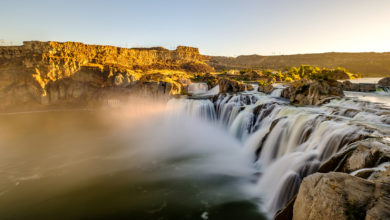What’s So Interesting About Idaho? Take a Look
6 things about The Gem State that make it different from anyplace else

The state of Idaho in the northwestern United States is home to more than 1.7 million Americans. You’ve probably seen “Idaho” stamped or printed on bags of potatoes you buy at the grocery store. Idaho is also home to Red Rock Pass, Shoshone Falls, Albertson’s Stadium and the Craters of the Moon National Monument and Preserve. And if you’re thinking there’s not that much to write home about when it comes to the Potato State, have we got some surprises for you—six of them, to be exact!

Idaho is the Gem State
Idaho is called the Gem State for two reasons. Idahoans see their beloved state as a gem when it comes to an abundance of scenic areas and beautiful landscapes. The state is known for its glorious backdrops of snow-capped mountains, steep canyons, magnificent waterfalls, whitewater rapids, expansive lakes and more. It’s also literally the Gem State because of the plethora of natural resources found there. Idahoan mountains contain zinc, cobalt, lead, gold, and silver, as well as rare minerals like star garnets—Idaho’s state gem—jasper, zircon, tourmaline, opal, jade, and topaz. In fact, there are more than 72 gems found in Idaho’s mountains.

Idaho has a nearly perfect ratio
A gender ratio, that is. The national average ratio of men to women is 97:100. But in the state of Idaho, the ratios are even more favorable. The ratio of men to women is a cool 100:100. Perhaps nowhere in the country is the old saying, “There’s someone for everyone” more true than in Idaho.

Hell’s Canyon
Hell’s Canyon is a 10-mile-wide canyon located on the border of western Idaho, eastern Oregon and eastern Washington, and with a depth of 7,993 feet, it’s North America’s deepest river gorge. It was carved by the Snake River over a period of thousands of years.

Hell’s Canyon National Recreation Area in Lewis-Clark Valley, Idaho, encompasses an area of more than 650,000 acres. The recreation area was created in 1975 and offers visitors activities such as fishing, hiking, camping and whitewater sports. Snake River is at the center of many of those activities, as it is abundant in fish and boasts Class I to Class IV rapids, as well as diverse wildlife. There are also miles of trails around the river where visitors can hike and explore the untouched nature of the area.

Sun Valley
Sun Valley is southern Idaho’s winter sports playground. It gained notoriety in the late 1930s when author Ernest Hemingway came to visit at the invitation from the head of Union Pacific Railroad. It was in Sun Valley that the famed author penned For Whom the Bell Tolls in 1939. Hemingway’s visit paved the way for other celebrities and members of the elite to visit the wintry playground. Many celebrities even set up their seasonal homes here. In the 1960s, an episode of “The Lucy and Desi Comedy Hour” was filmed in Sun Valley. In that episode, Lucy and Ethel set off to Sun Valley without Ricky and Fred and are starstruck when they cross (ski) paths with actor Fernando Lamas.
If winter sports like skiing and ice skating are your claims to fame, Sun Valley offers some of the best in winter recreation opportunities. Bold Mountain and Dollar Mountain are great places for downhill skiing for all skill levels. For more information about all there is to see and do in Sun Valley, click www.visitsunvalley.com.

Potatoes
Idaho is responsible for the production of 1/3 of all the potatoes sold and consumed in the United States. Most potatoes in Idaho are of one variety—the Russet Burbank, or as they are more commonly called, russets. Idaho produces 13 billion pounds of potatoes each and every year. But potatoes weren’t first introduced to the people of Idaho by a farmer, but by a Presbyterian missionary who was in the area to spread Christianity to the natives. He taught them how to grow and harvest potatoes. Later, it was Mormon colonists who owned the first substantial potato fields in Idaho—but this was accidental, as the colonists settled in the area because they believed they were still in Utah.
So what makes Idahoan potatoes the best? Is there really a difference between “Grown in Idaho” potatoes and those grown in other states? If you’re asking an Idahoan, the answer is simple. Their potatoes not only taste better, but they result in fluffier baked potatoes and better tasting mashed potatoes with a more consistent texture. They credit mountain-fed irrigation and rich volcanic soil for their potatoes’ unrivaled taste.

Miles and miles of rivers
Perhaps one of the most amazing things about Idaho is all the water in the state. Though early explorers first thought the area was dry and barren, we now know that there are more than 107,000 miles of rivers and other waterways throughout the state. Of those 107,000-plus miles of waterways, 891 miles are designated as wild and scenic. There are enough miles of water running through Idaho to stretch across the entire United States 38 times!




